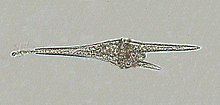囊泡虫
| 囊泡虫类 化石时期:
| |
|---|---|

| |
| 叉角藻 | |
| 科学分类 | |
| 演化支: | SAR 超类群 SAR |
| 演化支: | 囊泡虫类 Alveolata |
| 门 | |
囊泡虫总门(学名:Alveolata)[2]是一大类原生生物.
门[编辑]
囊泡虫类可分为4个门, 在形态上具有非常大的多样性,但根据细胞内的超微结构与基因具有密切亲缘关系:
- 顶复门(Apicomplexa) - 营寄生的原生生物,缺少轴丝运动结构,但是配子例外;
- 色虫门(Chromerida) - 一种具有光合自养的海生原生动物,是顶复门与藻类的进化过渡的中间物种;
- 纤毛虫门(Ciliate) - 非常常见的原生动物,具有成排的纤毛
- 双鞭毛虫门(Dinoflagellate) - 大都是海生鞭毛虫,往往有叶绿体
帕金虫属(Perkinsus)可能属于另一个进化分枝 - 帕金虫门(Perkinsozoa) - 基于许多分子生物学证据.[3]
特征[编辑]
囊泡虫最著名的公共特征是存在皮层内生膜囊(cortical alveoli), 扁平的囊泡折叠为连续层支撑着膜,通常形成灵活的薄皮。双鞭毛虫通常形成硬壳。 囊泡虫具有带管状嵴的线粒体。鞭毛或纤毛有不同结构.
这类原生生物的祖先显然是营光合作用的.[4]
几乎所有的纤毛虫与顶复门寄生虫的线粒体基因组是线状的.[5]巴贝斯原虫(Babesia microti)的线粒体基因是环形的.[6]这个物种因而被认为不属于巴贝斯虫属(Babesia)或泰勒虫属(Theileria),应该为它创建一个新的属。
分类[编辑]
顶复门与双鞭毛虫门具有很近的亲缘关系,被合称为粘孢子总门,而纤毛虫门则比较疏远。顶复门与双鞭毛虫门都有色素体,在细胞顶部大都有一束或圆锥形微管. 对于顶复门生物,这形成了顶复器用于进入宿主细胞。某些无色的双鞭毛虫这形成了口器用于摄入被掠食的微生物。其它囊泡虫类的生物与这两类具有不同远近的亲缘关系,大部分鞭毛虫有类似的顶器结构。这包括自由生活的Oxyrrhis与Colponema, 营寄生的Perkinsus, Parvilucifera, Rastrimonas与ellobiopsid. 2001年, 对海洋微微型浮游生物样本的rRNA研究表明,存在两个新的囊泡虫进化世系,称作group I与II.[7][8]Group I没有近缘亲属,而group II与双鞭毛虫门共甲藻目(Syndiniales)的寄生生物Amoebophrya亲缘很近.
在1980年代,提出了这几大类微生物可能属于一个进化分枝。1990年代通过基因研究证实了这一想法,特别是Gajadhar等人的研究工作.[9]汤玛斯·卡弗利尔-史密斯, 于1991年正式命名了囊泡虫总门(Alveolata),[10]在当时还认为这可能是一个并系群, 实际上后来证实是单系群.
某些研究认为最著名的海洋无脊椎动物的寄生虫haplosporid应该属于囊泡虫总目,但缺少腔区(alveoli),因此现在被分类在有孔虫界的丝足虫类.
发展[编辑]
囊泡虫的色素体的发展还不确定. 卡弗利尔-史密斯建议囊泡虫的祖先是一种有叶绿体的,并发展成了色藻界 (囊泡藻界假说). 但是,色素体只出现在相对衍生的(而不是比较古老的)群体, 其它人的观点是囊泡虫最初缺少色素体,可能是双鞭毛虫与顶复门生物分别独立获取色素体。
也很可能是囊泡虫总门与不等鞭毛总门的色素体这个细胞器有一个共同起源,是从红藻那里获得了色素体.[11]
进化[编辑]
囊泡虫的共同起源可能是一种吸食(myzocytotic)被掠食者的细胞,有两条鞭毛, 微孔, 刺丝胞(trichocyst), 棒状体(Rhoptry), microneme, polar ring与一个锥形顶部开口的顶器.[12]这个祖先可能拥有色素体,但还不清楚是否具有光合作用的能力。还不清楚现存的perkinsids与colpodellids是否还有这个细胞器.
参考文献[编辑]
- ^ Li, C.-W.; et al.. Ciliated protozoans from the Precambrian Doushantuo Formation, Wengan, South China. Geological Society, London, Special Publications. 2007, 286: 151–156. doi:10.1144/SP286.11.
- ^ alveolate. Memidex (WordNet) Dictionary/Thesaurus. [2011-01-26]. (原始内容存档于2016-04-11).
- ^ Zhang H, Campbell DA, Sturm NR, Dungan CF, Lin S (2011) Spliced leader RNAs, mitochondrial gene frameshifts and multi-protein phylogeny expand support for the genus Perkinsus as a unique group of Alveolates. PLoS One. 2011;6(5):e19933
- ^ Reyes-Prieto A, Moustafa A, Bhattacharya D. (2008) Multiple genes of apparent algal origin suggest ciliates may once have been photosynthetic. 18 (13):956-962
- ^ Barth D, Berendonk TU (2011) 纤毛虫门的草履虫的线粒体基因序列揭示了草履虫属的核苷组成与密码子使用的平移. BMC Genomics. 12:272
- ^ Cornillot E, Hadj-Kaddour K, Dassouli A, Noel B, Ranwez V, Vacherie B, Augagneur Y, Brès V, Duclos A, Randazzo S, Carcy B, Debierre-Grockiego F, Delbecq S, Moubri-Ménage K, Shams-Eldin H, Usmani-Brown S, Bringaud F, Wincker P, Vivarès CP, Schwarz RT, Schetters TP, Krause PJ, Gorenflot A, Berry V, Barbe V, Ben Mamoun C (2012) Sequencing of the smallest Apicomplexan genome from the human pathogen Babesia microti{dagger} Nucleic Acids Res
- ^ López-García, P. et al. (2001). Unexpected diversity of small eukaryotes in deep-sea Antarctic plankton. Nature 409: 603-7.
- ^ Moon-van der Staay, S. Y. et al. (2001). Oceanic 18S rDNA sequences from picoplankton reveal unsuspected eukaryotic diversity. Nature 409: 607-10.
- ^ Gajadhar, A. A.; et al. Ribosomal RNA sequences of Sarcocystis muris, Theilera annulata, and Crypthecodinium cohnii reveal evolutionary relationships among apicomplexans, dinoflagellates, and ciliates. Molecular and Biochemical Parasitology. 1991, 45: 147–153. doi:10.1016/0166-6851(91)90036-6.
- ^ Cavalier-Smith, T. (1991). Cell diversification in heterotrophic flagellates. In The Biology of Free-living Heterotrophic Flagellates, ed. D.J. Patterson & J. Larsen. pp. 113-131. Oxford University Press.
- ^ Janouskovec J, Horák A, Oborník M, Lukes J, Keeling PJ (2010) A common red algal origin of the apicomplexan, dinoflagellate, and heterokont plastids. Proc Natl Acad Sci USA 107(24):10949-10954
- ^ Kuvardina ON, Leander BS, Aleshin VV, Myl'nikov AP, Keeling PJ, Simdyanov TG (2002) The phylogeny of colpodellids (Alveolata) using small subunit rRNA gene sequences suggests they are the free living sister group to apicomplexans. J Eukaryot Microbiol 49(6):498-504
外部链接[编辑]
| ||||||||||||||||||||||||||||||||||||||||||||||||||||||||||||||||||||||||||||||||||||||||||||||||||||||||||||||||||||||||||||||||||||||||||||||||||||||||||||||||
|
